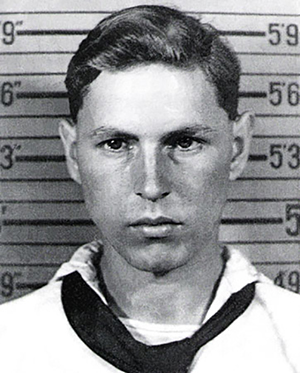
photo (Memorial No. 56126037) courtesy of Tx Oma

Remember...
George Dana Mollohan
1923-1944
"We know that enduring peace cannot be bought at the cost of other people's freedom."
- President Franklin D. Roosevelt
George Dana Mollohan was one of three brothers, sons of Thurmond Roy (known by family and folks in the community as Roy) and Hallie Alma Hill Mollohan. Carl, Orval, and George served simultaneously in World War II. The latter was born on September 19, 1923, at Duck, West Virginia. The oldest brother, Carlton Thurman (Carl), had enlisted in the U.S. Army in 1941, serving as a role model for Orval and George. Roy and Alma's family grew substantially with the addition of four daughters: Mary Jean, Margaret Hope, Betty Helen, and Evelyn Joan. According to the 1940 Federal Census, George was working as a laborer, having left school after the eighth grade.
While enlistment in the U.S. Army was Carl's way of fleeing depression-ravaged West Virginia, Orval and George headed to California to find employment. But World War II was looming, and the military beckoned. Orval would end up in the army, like Carl, but George Dana was headed for Naval service. He became a torpedoman's mate, second class, aboard the USS Trout. In her application to the West Virginia Legislature to have a bridge named for her uncles, a niece writes:
Oddly, the USS Trout delivered ammunition to the US Army at Corregidor, Philippines in January 1942, a time when it was likely his older brother Orval was on the Bataan Peninsula with the 31st Infantry. Following delivery of ammunition, the USS Trout took on gold from Philippine banks ahead of the Japanese capture of Manila. George had been awarded the Purple Heart Medal for coming under fire while serving aboard the Trout. From Japanese records it is likely that the USS Trout was destroyed sometime after 16 February 1944 after refueling at Midway and beginning a patrol of the western Pacific. Neither the Trout nor any of the crew have been recovered.
The USS Trout was a highly decorated World War II submarine with much history and numerous commendations to her credit:
[She] was the fifth Tambor-class submarine commissioned in the United States Navy, serving in the Pacific from 1941 to 1944. She received 11 battle stars for World War II service and [the] Presidential Unit Citation for her second, third, and fifth war patrols. Trout also delivered ammunition to the besieged American forces on Corregidor and brought out 20 tons of gold bars and silver pesos from the Philippine currency reserve to Pearl Harbor. During 1941, she was used as a target by a series of tests determining the vulnerability of submarines to depth charge attacks.Trout is credited with sinking 12 enemy ships for 37,144 tons according to JANAC records. During her first ten war patrols she made 32 torpedo attacks, firing 85 torpedoes, including 34 hits, 5 confirmed premature detonations, 5 confirmed duds, and 25 suspected duds. She was also involved in six battle surface actions and was attacked with depth charges eight times. ("USS Trout," Wikipedia, last edited 8 February 2025, accessed 25 March 2025, https://en.wikipedia.org/wiki/USS_Trout_(SS-202).)
Article prepared by Patricia Richards McClure
October 2025

West Virginia Archives and History welcomes any additional information that can be provided about these veterans, including photographs, family names, letters and other relevant personal history.